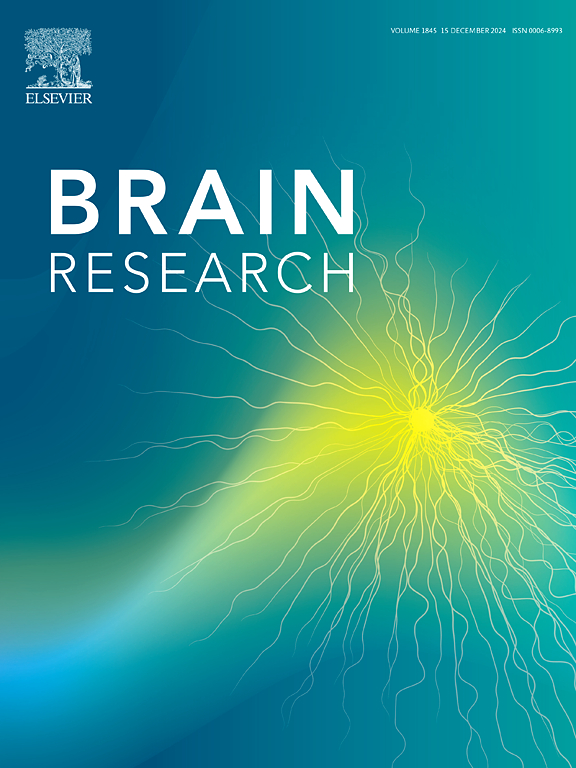氟哌啶醇长期治疗可调节血管紧张素i转换酶(ACE)活性,并可用于精神分裂症研究
IF 2.7
4区 医学
Q3 NEUROSCIENCES
引用次数: 0
摘要
血管紧张素i转换酶(ACE)活性升高与首发精神病(FEP)和慢性精神分裂症(SZ)患者认知能力下降相关。在这项研究中,我们研究了与野生型(WT)对照相比,过表达全长非突变人精神分裂症1 (tgDISC1)的drug-naïve转基因大鼠的ACE活性,同时我们还评估了典型抗精神病药氟哌啶醇长期治疗的效果。我们的研究结果表明,与WT动物相比,未经治疗的tgDISC1大鼠血清ACE活性升高,这与drug-naïve FEP患者的临床观察结果一致。相比之下,tgDISC1大脑的ACE基线活性普遍低于WT大鼠,但在与学习、记忆和奖励相关的大脑区域,如海马和伏隔核,ACE活性无差异。与FEP患者在抗精神病药物治疗后的临床观察一致,每日氟哌啶醇治疗30天可显著提高tgDISC1和WT大鼠血清中ACE活性。然而,脑内ACE反应明显不同,因为氟哌啶醇治疗降低了两种大鼠大部分脑区的ACE活性。这些结果支持中枢肾素-血管紧张素系统(RAS)与外周RAS不同的存在,表明多巴胺阻断剂治疗对ACE活性具有脑特异性作用,这与外周观察到的结果基本相反。在认知相关脑区观察到的这种区域特异性改变(特别是与WT大鼠相比,tgDISC1海马和伏隔核的效应大小相对更强)也表明,SZ的多巴胺稳态、ACE活性和认知缺陷之间存在关键的相互作用。了解这种相互作用有助于确定新的生物标志物和/或治疗策略,以改善SZ患者的认知结果。本文章由计算机程序翻译,如有差异,请以英文原文为准。

Long-term treatment with haloperidol modulates angiotensin I-converting enzyme (ACE) activity in transgenic animal model with construct validity for schizophrenia studies
Elevated angiotensin I-converting enzyme (ACE) activity has been correlated with worse cognitive performance in patients with first-episode psychosis (FEP) and chronic schizophrenia (SZ). In this study, we investigated ACE activity in drug-naïve transgenic rats overexpressing the full-length non-mutated human Disrupted-in-Schizophrenia 1 (tgDISC1) compared to wild-type (WT) controls, while we also assessed the effects of long-term treatment with typical antipsychotic haloperidol. Our findings indicated that untreated tgDISC1 rats show elevated serum ACE activity compared to WT animals, which is consistent with clinical observations in drug-naïve FEP patients. In contrast, baseline ACE activity in the brain of tgDISC1 was generally lower than in WT rats, with the exception of no difference in ACE activity observed in brain regions associated with learning, memory, and reward, such as the hippocampus and nucleus accumbens. Consistent with clinical observations in FEP patients following treatment with antipsychotics, 30-days of daily haloperidol-treatment significantly increased serum ACE activity in blood serum of both tgDISC1 and WT rats. However, ACE responses in brain were markedly different, as haloperidol treatment reduced ACE activity in most brain regions of both rat strains. These results support the existence of a central renin-angiotensin system (RAS) distinct from the peripheral RAS, suggesting that the treatment with a dopamine blocker exerts brain-specific effects on ACE activity, which was essentially opposite to that observed in the periphery. This region-specific alterations observed in cognition-related brain areas (notably with a relative stronger effect size in hippocampus and nucleus accumbens of tgDISC1 compared to WT rats) also suggest a critical interplay among dopamine homeostasis, ACE activity, and cognitive deficits in SZ. Understanding this interplay could help identifying novel biomarkers and/or therapeutic strategies for improving cognitive outcomes in SZ patients.
求助全文
通过发布文献求助,成功后即可免费获取论文全文。
去求助
来源期刊

Brain Research
医学-神经科学
CiteScore
5.90
自引率
3.40%
发文量
268
审稿时长
47 days
期刊介绍:
An international multidisciplinary journal devoted to fundamental research in the brain sciences.
Brain Research publishes papers reporting interdisciplinary investigations of nervous system structure and function that are of general interest to the international community of neuroscientists. As is evident from the journals name, its scope is broad, ranging from cellular and molecular studies through systems neuroscience, cognition and disease. Invited reviews are also published; suggestions for and inquiries about potential reviews are welcomed.
With the appearance of the final issue of the 2011 subscription, Vol. 67/1-2 (24 June 2011), Brain Research Reviews has ceased publication as a distinct journal separate from Brain Research. Review articles accepted for Brain Research are now published in that journal.
 求助内容:
求助内容: 应助结果提醒方式:
应助结果提醒方式:


